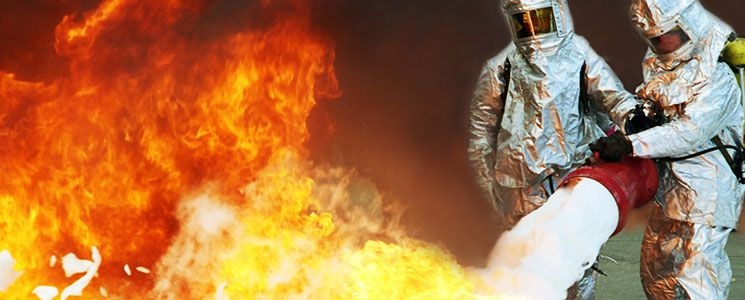 14/06/2017
14/06/2017
The difference between fluorine-free and fluorine-containing extinguishing foam
In the media a number of terms are repeatedly used with regard to toxic extinguishing foam . Fluorine, PFOA, C8 and C6. But what do these terms exactly mean and how are they related? You will read everything about this in this new blogpost.
What is fluorine exactly?
Fluorine in relation to extinguishing foam refers to adding fluorinated hydrocarbon compounds. These compounds are responsible for the film layer that gives foam its superior extinguishing effect. Until a few years ago fluorine compounds were used for extinguishing a fire which consisted of molecule chains with 8 or more carbon atoms as backbone. Hence the name C8. For compounds with even more carbon atoms we use the term Cx.
What is the difference between C8 and PFOA?
In extinguishing foam there are several fluorinated hydrocarbon compounds in which 8 carbon atoms form the backbone. Within the large group of C8 compounds there are numerous substances which are completely harmless for humans and the environment. Unfortunately, there are also C8 compounds of which it has been sufficiently proved that they are very harmful. An example of this is PFOS. About ten years ago there was much controversy about PFOS, which was the reason for 3M to stop with the production of these specific extinguishing foams. In other extinguishing foams there were no traces of PFOS.
The substance PFOA, which is currently much in the news, also has one chain of 8 carbon atoms. PFOA is therefore a C8 compound with the same backbone as the fluorine compounds that were used until recently in extinguishing foam. Science has already proved that PFOA is toxic, persistent and bio-accumulative to a certain extent. However, the extent in which the substance also actually may have carcinogenic effects with humans and animals is still a matter for discussion. Studies on this subject have not resulted in definitive conclusions yet, however at this stage there are strong indications1).
The advantage of C6 extinguishing foam
Nowadays a completely different chemical composition in fluorine-containing extinguishing foams is applied. Carbon chains of 6 carbon atoms (C6) are used< instead of C8. Under the supervision of the American environmental body EPA extinguishing foam producers decided to not use C8 compounds anymore in extinguishing foam. The phasing out of the C8-fluorine compounds has been realised in recent years. Modern extinguishing foams are therefore produced with chains of 6 carbon atoms and this is why they are called C6. A fluorine compound with only 6 carbon atoms as backbone cannot form any hazardous variants of C8, such as PFOA.
And what about fluorine-free extinguishing foam? Unfortunately, no extinguishing foams are environmentally friendly2). This also applies to fluorine-free foam. On the contrary, fluorine-free foam may be many times more harmful for the environment than fluorine-containing foam, depending on th compliance criteria. For example, there are aquatic microbes in surface water which degrade environmentally unfriendly substances. Research3) shows that these microbes have an extremely high oxygen demand when so-called ‘environmentally friendly’ components are degraded in fluorine-free extinguishing foam. When fluorine- free foam is dumped in a ditch, the result is that the ditch will not have any other form of life anymore within a short time. Another study4) shows that it may take many years before life returns. Fluorine-free foam is therefore certainly harmful when effects in the short and medium term are considered. It therefore does not comply at all with the generally accepted definitions of environmentally friendliness.
What is the environmental impact of a fire?
Now that the focus is mainly on whether extinguishing foam includes fluorine or not, we ignore what is really essential. In the case of a disastrous fire we unfortunately have to choose between two evils. Should we fight the fire in the most effective way, or should we fight it in a less effective way.
Because fluorine-free foam is a relatively new technique, this type of foam simply does not have the same qualities yet as the conventional, fluorine-containing, synthetic foams. This means that on balance more fluorine-free foam will have to be used and it will take more time to fight a fire effectively. The immediate result is twofold. First of all, the total environmental impact will increase, because there will be emissions of harmful gases in the smoke for a longer period. Secondly, we use more foam-forming liquid, which also has its impact on the environment. The quality and effectiveness of a certain foam with regard to extinguishing a fire can fortunately be found in the various types of authorisations. It is a fact that fluorine-free foams have a structurally lower score in the ratings than fluorine-containing foams and are therefore less effective. In a next blogpost we will return to this issue with a rating table.
The most important aim is to fight a fire in the most effective way with the least possible impact on humans and the environment.



